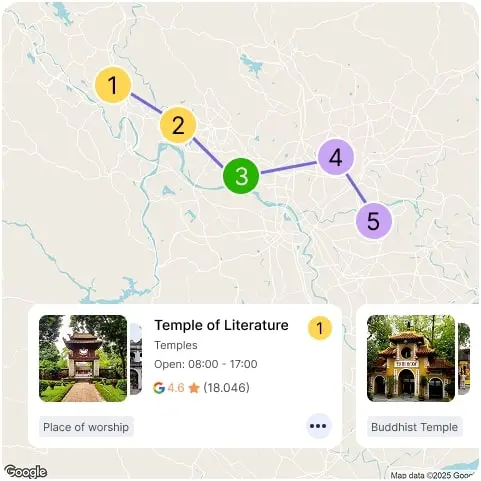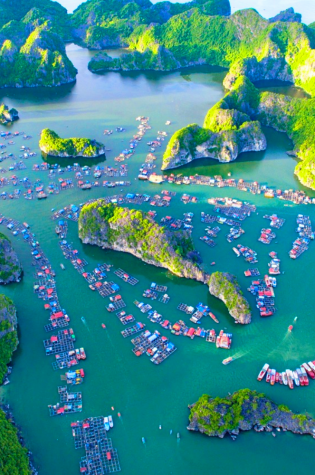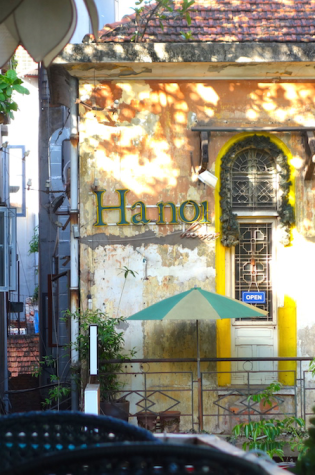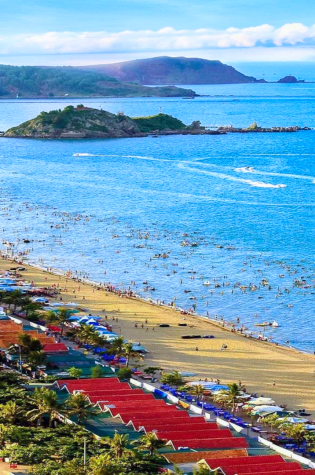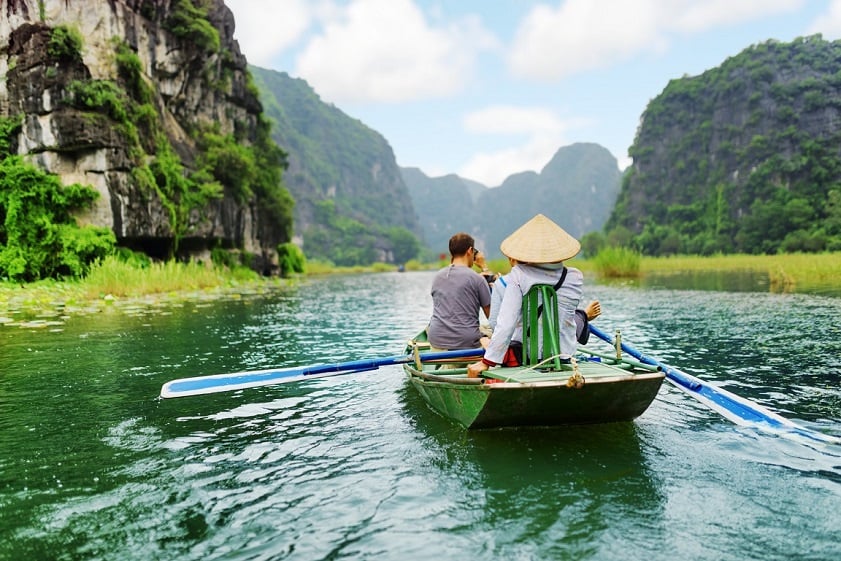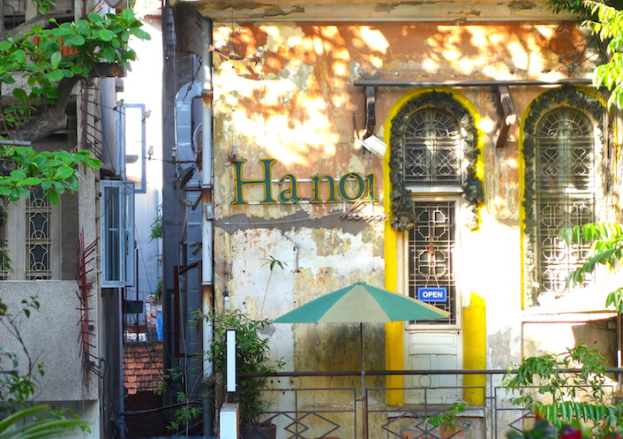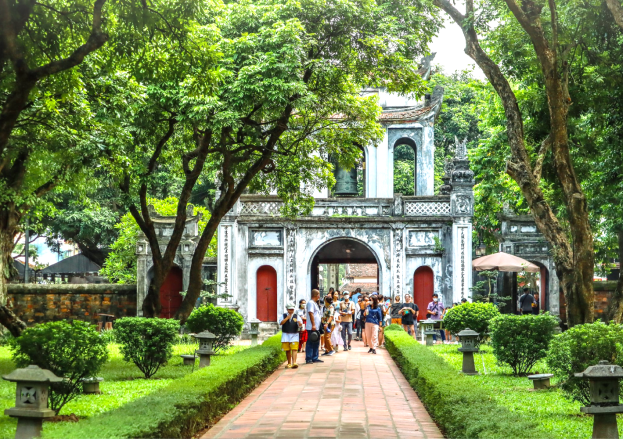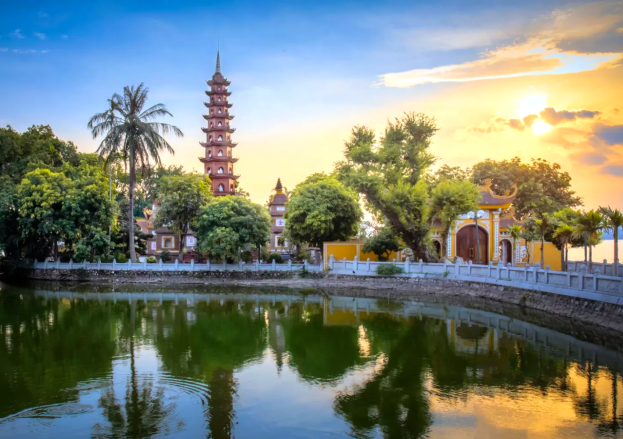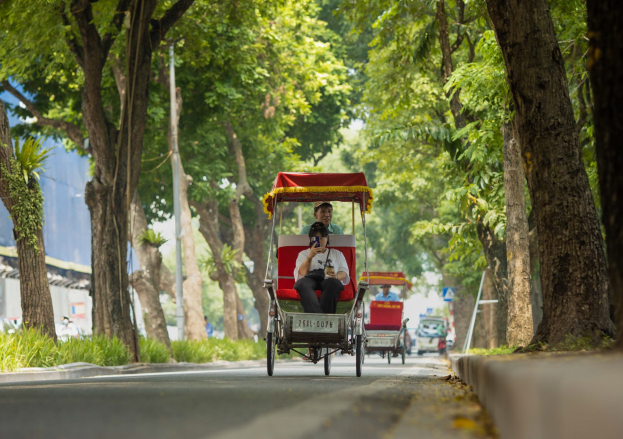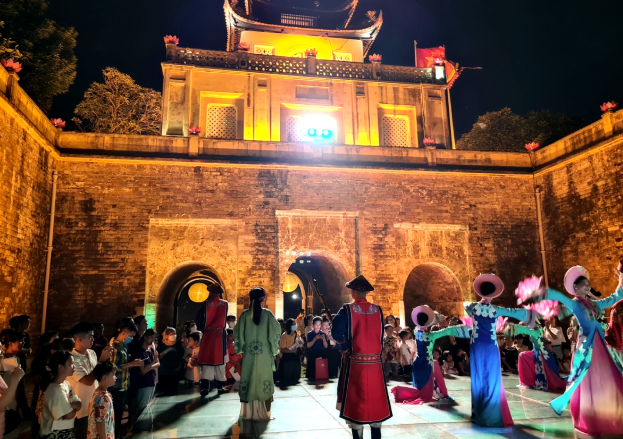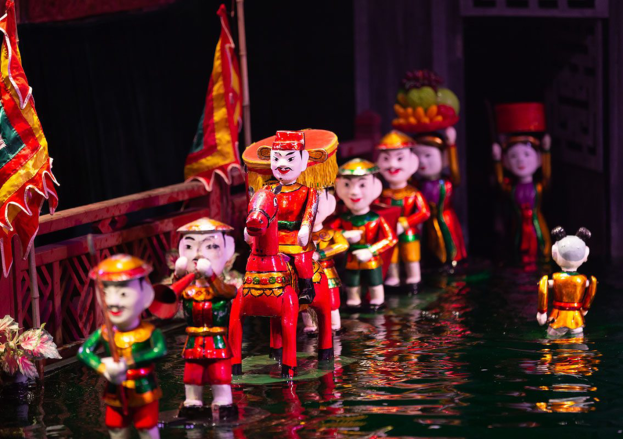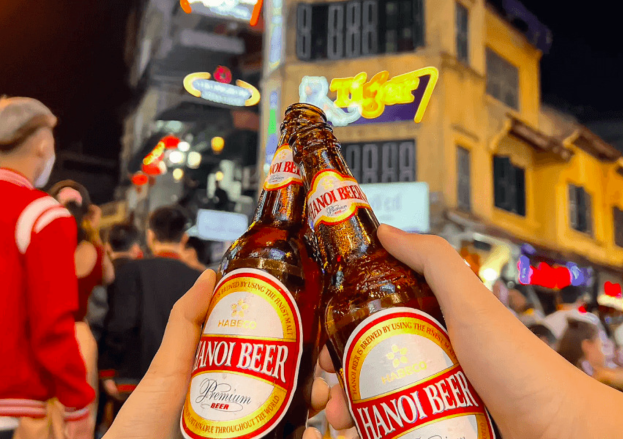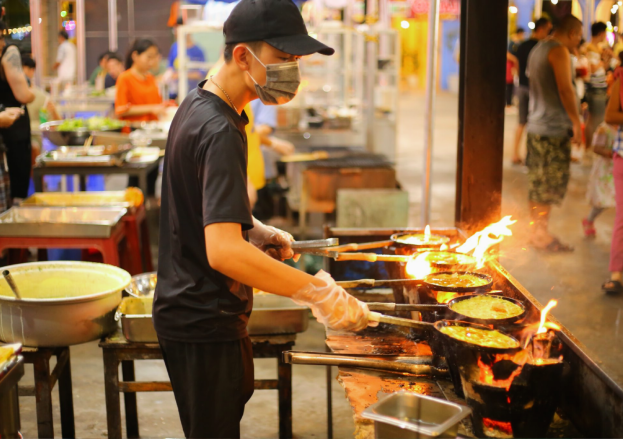
Floating Markets
Step into the lively world of Vietnam’s floating markets, navigate through canals, interact with vendors, and taste fresh local specialties while experiencing the rhythm of river life.

Cai Be Floating Market: A vibrant river marketplace in Tien Giang
04 Sep, 2025
A Colorful Scene on the River Arriving at the market in the early morning, you are immediately immersed in a symphony of sights, sounds, and smells. Boats piled high with fresh fruits, vegetables, and local goods float gently along the river, their vibrant colors reflecting on the water. Vendors call out the names of their products in rhythmic tones, creating an energetic yet harmonious melody that fills the air. The market is not only a hub of commerce but also a center of social interaction. Fishermen, farmers, and local traders navigate their boats skillfully, balancing baskets of produce while exchanging friendly greetings with neighbors. Children play along the edges of boats, dipping their hands into the water, adding a touch of joy and life to the scene. Drifting through Cai Be is like watching a living painting, where every boat tells a story of the delta’s traditions and daily routines. Culinary Delights on the Water One of the most enchanting aspects of Cai Be Floating Market is the floating kitchens. Many boats serve freshly prepared local dishes, allowing travelers to taste the Mekong Delta right on the water. From steaming bowls of hu tieu (rice noodle soup) to sticky rice with coconut and freshly grilled fish, the flavors are vibrant, fresh, and deeply connected to the river. Sitting on your boat, enjoying a meal while gently drifting past vendors and customers, creates a sensory experience unlike any other. The aroma of local herbs and spices mingles with the morning air, while the rhythmic splash of paddles and calls of vendors form a natural soundtrack. Interacting with the boat owners and cooks adds a cultural layer to the culinary experience, offering insights into their lives and culinary traditions. Experiencing the Market’s Rhythm Time flows differently at Cai Be Floating Market. Early mornings are the liveliest, with boats packed tightly as trade peaks. By mid-morning, the market gradually quiets, and the pace slows, allowing visitors to absorb the beauty and serenity of the delta. For travelers willing to wake before dawn, drifting along the river offers more than sightseeing—it provides an authentic connection to the daily life, culture, and traditions of the Mekong Delta. Observing the skillful navigation of boats, the careful handling of goods, and the friendly interactions between locals creates a deeper appreciation for the ingenuity and resilience of the delta’s people. Tips for Visitors Visiting Cai Be Floating Market can be overwhelming at first with the vibrant colors, lively boats, and bustling activity. To make the most of your experience and fully enjoy the sights, sounds, and flavors of the market, here are some practical tips for travelers. Arrive Early: To truly experience the energy of Cai Be Floating Market, aim to arrive between 5:00 and 8:00 AM. This is when the market is at its liveliest, with boats loaded with fresh fruits, vegetables, and seafood drifting along the river. Arriving early ensures you catch the market in its most authentic and vibrant state, before it becomes less busy later in the day. Take a boat tour: Exploring the market by boat is essential for a complete experience. Small boats or sampans allow you to navigate the narrow waterways, pass through the bustling clusters of floating vendors, and reach quieter areas where fewer tourists venture. Taste local dishes: Cai Be is famous for its floating kitchens, and sampling the local food is a must. Many vendors serve freshly cooked meals directly from their boats, including dishes like hu tieu (rice noodle soup), sticky rice with coconut, or grilled river fish. Eating while floating on the river enhances the experience—the aromas of herbs, spices, and freshly cooked food mix with the morning air, creating an authentic taste of Mekong Delta life. Bring a camera: Capture the vibrant colors, the busy boats, and the scenic riverside views. Hire a local guide: For visitors who want a deeper understanding of the market, hiring a local guide can be invaluable. Guides can explain the history of Cai Be Floating Market, the traditions of river trade, and the unique way locals live and work on the water. They can also help you navigate the market, point out interesting stalls, and introduce you to culinary specialties or unusual products that you might otherwise miss. Cai Be Floating Market is more than just a marketplace; it is a living cultural experience. The blend of colors, flavors, and river life creates a unique glimpse into the soul of the Mekong Delta. Whether you are sampling fresh local dishes, drifting past vibrant boats, or simply observing daily life unfold, a visit to Cai Be promises an unforgettable journey that lingers in memory long after you leave the river.
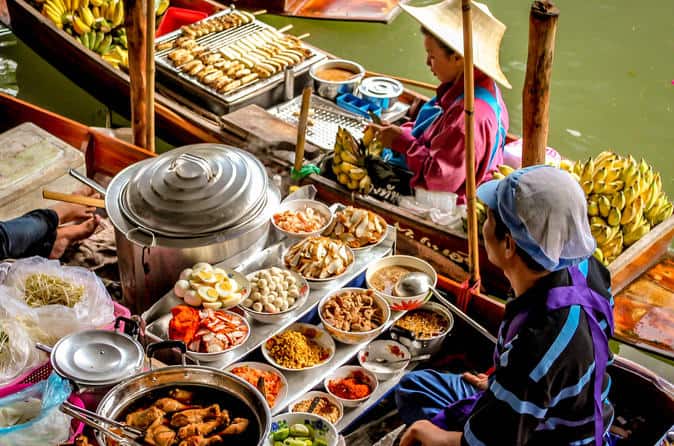
Drifting through Ca Mau Floating Market and savoring fresh local dishes
04 Sep, 2025
A Living Mosaic on the Water The market is a vibrant mosaic of colors, sounds, and scents. Bright yellow mangoes, deep green vegetables, and baskets of glistening seafood are stacked high on narrow wooden boats, bobbing gently with the current. Fishermen unload the morning’s catch—shrimp, crabs, and various river fish—while farmers balance baskets of fruits and vegetables, navigating their boats skillfully through the crowded waterway. The calls of vendors fill the air in a melodic rhythm, each shouting out the names and prices of their goods in a lively and inviting tone. Children play along the edges of the boats, occasionally dipping their hands into the water, their laughter mingling with the splashes of oars. The scene feels alive, almost cinematic, with every boat carrying not just goods but stories, traditions, and the very essence of life along the river. Travelers drifting through the market can’t help but be drawn into the motion and energy. The market is not just a place to buy and sell; it is a stage where daily life unfolds in its most authentic form. Unlike tourist-centric markets, here, the rhythm of the market is dictated by locals who have honed their skills over decades, passing their knowledge and techniques down through generations. A Culinary Journey Among the Boats Perhaps the most unforgettable part of visiting Ca Mau Floating Market is the floating kitchens. Many boats are transformed into miniature restaurants, offering freshly prepared meals to hungry travelers and local shoppers alike. The aroma of piping hot hu tieu (rice noodle soup), sticky rice with coconut, or grilled river fish floats across the water, mingling with the scents of herbs, spices, and the morning air. Sitting on your boat and sampling these dishes is more than just eating—it is participating in a living tradition. The flavors are fresh, vibrant, and deeply connected to the river itself. Each bite reflects the labor and care of the vendors, from the careful selection of the freshest ingredients to the precise cooking methods passed down through generations. Coffee is brewed on small portable stoves, its strong aroma mixing with the smell of river fish and tropical fruits, creating an unmistakable sense of place that can only be experienced here. This culinary adventure is also a social one. Vendors often invite visitors to taste their dishes, sharing stories about recipes, family traditions, and the history of the market. Every interaction feels personal and authentic, offering a rare opportunity to connect with the people who have made the river their home. Embracing the River’s Pace Time moves differently at Ca Mau Floating Market. While many travelers are accustomed to rushing from sight to sight, here the current sets the pace. Drifting along the river encourages observation and reflection. You notice small details: a basket of freshly harvested vegetables teetering on the edge of a boat, the rhythmic splash of paddles, or a vendor skillfully balancing a tray of mangos while exchanging coins with a customer. As the sun rises higher, the market gradually quiets. Boats leave one by one, the chatter softens, and the river settles back into calm. Yet the memory of the market’s colors, sounds, and flavors lingers. Floating through Ca Mau offers more than sightseeing; it is a lesson in patience, observation, and appreciation for a way of life that has endured for centuries. For those willing to wake before dawn and let the river guide them, Ca Mau Floating Market is a treasure trove of experiences. It is where commerce meets culture, food meets tradition, and every turn of the boat reveals a new story. Here, the market is not merely a destination—it is an immersion into the soul of the Mekong Delta.
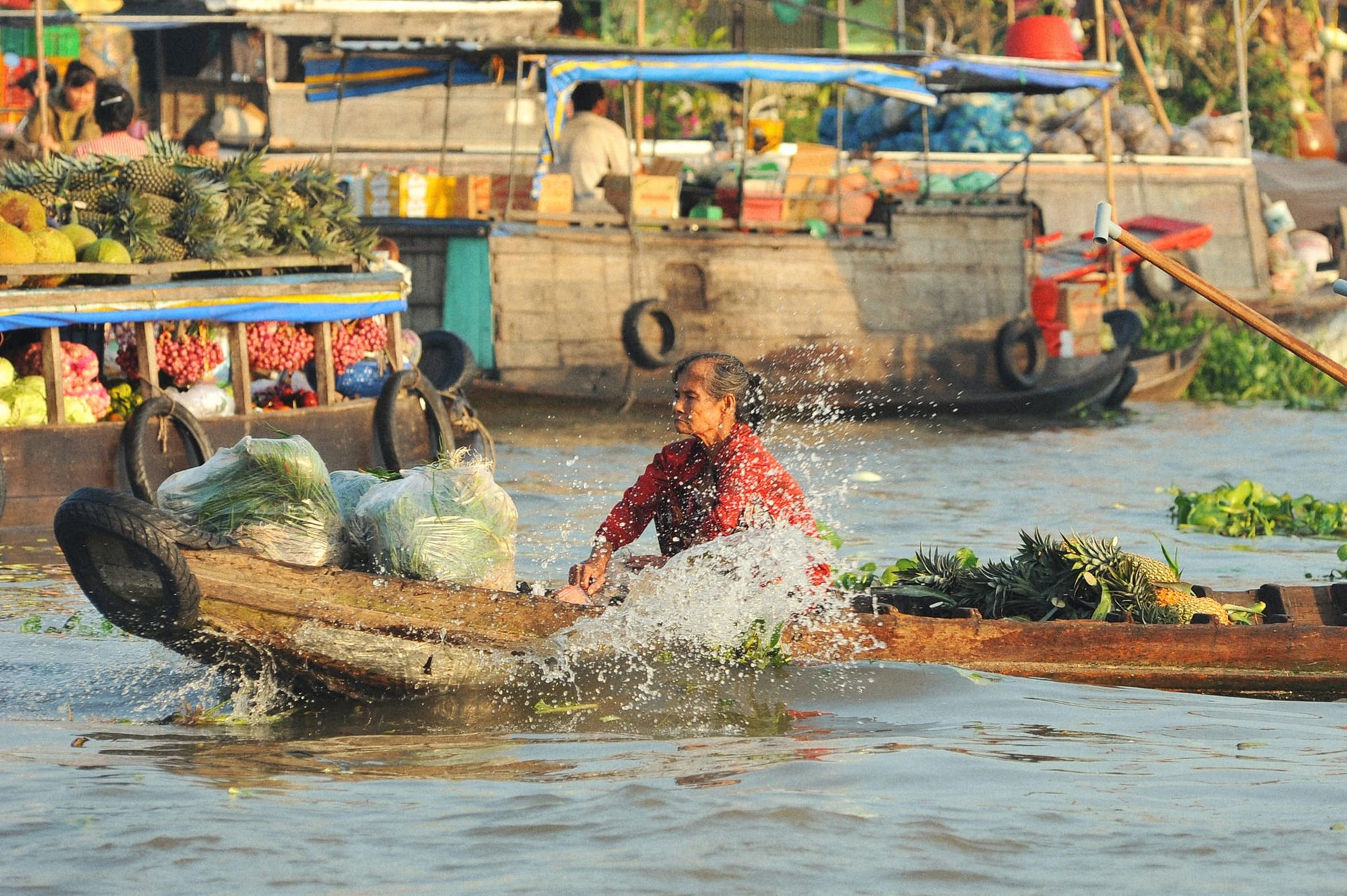
Experience the unique charm of Nga Nam Floating Market in Vietnam
04 Sep, 2025
A market at the meeting of five rivers Nga Nam literally means “five-way intersection.” True to its name, the market sits at the confluence of five rivers flowing in different directions—Can Tho, Vinh Quoi, Long My, Phu Loc, and Phuoc Long. This unique location makes it a natural hub for commerce, as boats from neighboring provinces converge here to buy, sell, and exchange products. From dawn, the waterways come alive with a colorful spectacle of boats piled high with goods, their poles hoisting samples of what’s on offer—from pineapples and pumpkins to fabrics and household items. A glimpse of local life Unlike more tourist-oriented markets, Nga Nam still retains its authentic character. Here, you’ll find locals bartering in their regional accents, fishermen delivering the morning’s catch, and farmers transporting fresh produce straight from their fields. It’s a place where transactions are quick, but the smiles and laughter shared across boats reveal the warmth of community life. The market also functions as a social space. Many vendors cook meals onboard their boats, turning them into floating kitchens that serve steaming bowls of noodle soup, hot coffee, or sticky rice. Sitting on a wooden plank while savoring breakfast amid the bustle of the river is an experience that captures the spirit of the Mekong Delta. Best time to visit The market begins before sunrise and is most vibrant between 4:00 AM and 7:00 AM, when hundreds of boats gather. Early risers are rewarded with breathtaking views of the sun rising over the rivers, casting golden light on the busy trading scene. After mid-morning, the market slowly quiets down as boats disperse and locals return to their villages. How to Get There Nga Nam is located about 60 kilometers from Soc Trang City and around 250 kilometers from Ho Chi Minh City. Travelers can reach the town by bus or private car, and then take a short boat ride to the floating market. While less accessible than some other markets, this remoteness is exactly what preserves its authenticity. Tips for Travelers Visiting Nga Nam Floating Market is a unique cultural journey, but to truly enjoy it, a bit of preparation goes a long way. Here are some practical tips to help you make the most of your experience on the bustling waterways. Arrive early to catch the market at its liveliest The floating market comes alive before dawn, usually around 4:00 AM. By getting there early, you’ll witness the busiest trading hours when boats are packed tightly together, shouting vendors negotiate prices, and the river reflects the first light of day. Not only will you experience the vibrant energy of the market, but you’ll also enjoy the breathtaking sunrise over the waterways—a sight that adds a magical touch to your visit. Bring a camera but also take time to absorb the atmosphere Nga Nam Floating Market is a photographer’s dream, with colorful boats, fresh produce stacked high, and the dynamic interplay of people on the river. While capturing photos is a must, don’t let the lens distract you entirely. Pause, set your camera down, and simply soak in the atmosphere—the sounds of paddles hitting the water, the aroma of cooking food drifting from floating kitchens, and the friendly greetings exchanged across boats. Try local dishes sold directly from the boats One of the highlights of visiting Nga Nam is the chance to savor Mekong Delta cuisine right on the water. Vendors cook onboard, turning their boats into small floating restaurants. You can enjoy steaming bowls of hu tieu (rice noodle soup), sticky rice with coconut, or even a simple cup of Vietnamese coffee brewed fresh on the spot. These dishes may look simple, but the flavors are rich, authentic, and deeply tied to local life. Eating breakfast while floating on the river is an unforgettable experience. Consider hiring a local guide for deeper insights While you can explore the market on your own, having a local guide can enrich the journey. They can explain the significance of the five-river intersection, share stories about the traders and their traditions, and even introduce you to friendly vendors. A guide can also help with translations, making interactions more meaningful. This added context transforms your visit from just sightseeing into a deeper cultural exchange. Nga Nam Floating Market is more than a trading hub—it’s a living museum of Vietnam’s waterborne culture. By visiting, you step into a world where rivers dictate life, trade thrives on trust, and tradition flows as naturally as the water itself. For travelers seeking an authentic Mekong Delta experience, Nga Nam is a hidden gem waiting to be explored.
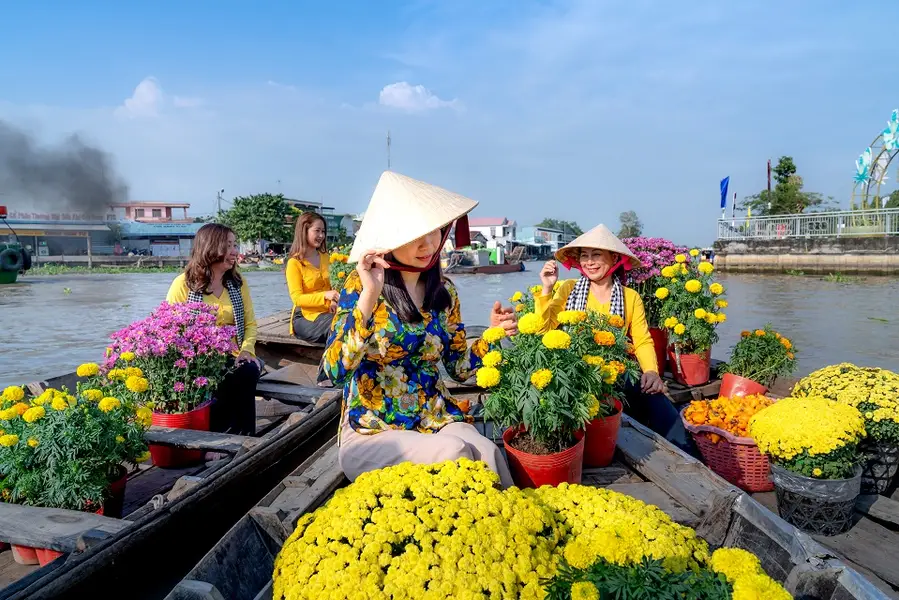
Discover the peaceful rhythm of Long Xuyen Floating Market
04 Sep, 2025
A River that Nurtures Life The Mekong Delta is often described as Vietnam’s “rice bowl,” a fertile land nourished by countless waterways. For generations, rivers have not only provided food and transportation but also shaped the way communities live, trade, and interact. The floating market is a natural extension of this lifestyle. In Long Xuyen, the Hau River becomes more than a waterway — it transforms into a bustling avenue of boats, each carrying the livelihood of families who call the river their home. A Morning Market Unlike Any Other To witness the market in full swing, visitors must rise early. By dawn, the river awakens with the hum of boat engines, the splashing of oars, and the cheerful calls of vendors. Wooden boats of all sizes gather, loaded with tropical fruits, vegetables, fish, and even household essentials. Instead of street signs, traders advertise their goods by tying a sample to a long bamboo pole. A pumpkin, pineapple, or papaya sways high above the boat, instantly telling buyers what’s on sale. Unlike urban markets filled with noise and crowds, Long Xuyen’s market unfolds in a slow, unhurried manner. The atmosphere is calm, allowing visitors to take in every detail — the smell of ripe mangoes, the shimmer of freshly caught fish, the sound of laughter echoing across the water. Life on the River The floating market is not just about trade; it is a reflection of life itself. Many families live permanently on their boats, turning them into floating homes complete with small kitchens, sleeping quarters, and even hammocks tied at the stern. Daily routines play out on the river — mothers cooking breakfast for their children, fishermen mending nets, and elders sipping tea while watching the sunrise. For outsiders, this way of life feels extraordinary, but for the locals, it is simply home. What makes Long Xuyen special is this intimacy. Here, commerce and community blend seamlessly, and visitors are invited to witness the resilience and warmth of the Mekong people. Tastes of the Market No trip to the market is complete without sampling its food. Vendors sell steaming bowls of hu tieu (noodle soup), fragrant banh mi, and freshly brewed coffee, all served from tiny cooking stations on boats. There is something magical about eating breakfast while drifting on the river, surrounded by the chatter of vendors and the gentle rocking of the water. Travelers who linger long enough may even be offered a taste of homegrown fruit — sweet longans, juicy pineapples, or a slice of watermelon — accompanied by the ever-present smile of the locals. The Charm of Authenticity While Cai Rang Floating Market has grown into a major tourist attraction, Long Xuyen remains authentic, catering primarily to locals. This lack of commercialization is precisely what sets it apart. Visitors are not spectators of a staged performance; they are participants in a genuine cultural tradition. The experience feels less like a sightseeing trip and more like being welcomed into the morning routine of a river community. The true appeal of Long Xuyen lies in its peaceful rhythm. It is a reminder that travel is not always about ticking off famous landmarks but about slowing down, observing, and connecting with people. The market offers a rare chance to step away from hurried itineraries and immerse in the timeless flow of Mekong life. For photographers, the soft morning light reflecting off the water creates stunning scenes. For cultural enthusiasts, every detail — from the boats’ wooden textures to the dialects spoken by vendors — tells a story of resilience and adaptation. Tips for Visitors To make the most of your trip to Long Xuyen Floating Market, here are a few practical tips that will help you enjoy the experience like a local: Best time to visit: Arrive between 5:00–7:00 AM to catch the liveliest moments. After 8:00 AM, trading activity gradually slows down. Getting there: Long Xuyen city is about 3–4 hours from Can Tho by car. From the city center, you can hire a boat to reach the market. What to bring: A hat, sunscreen, and camera. Morning light is ideal for photography, but don’t forget to simply enjoy the experience beyond the lens. Cultural note: Be respectful. The market is primarily for locals, so engage with friendliness and avoid intrusive behavior. While in Long Xuyen, visitors can explore more of An Giang’s cultural and natural beauty. Nearby attractions include Ong Ho Islet, home to traditional houses and lush gardens, and Tra Su Cajuput Forest, famous for its serene canals and birdlife. Together, these experiences paint a fuller picture of the province’s charm.
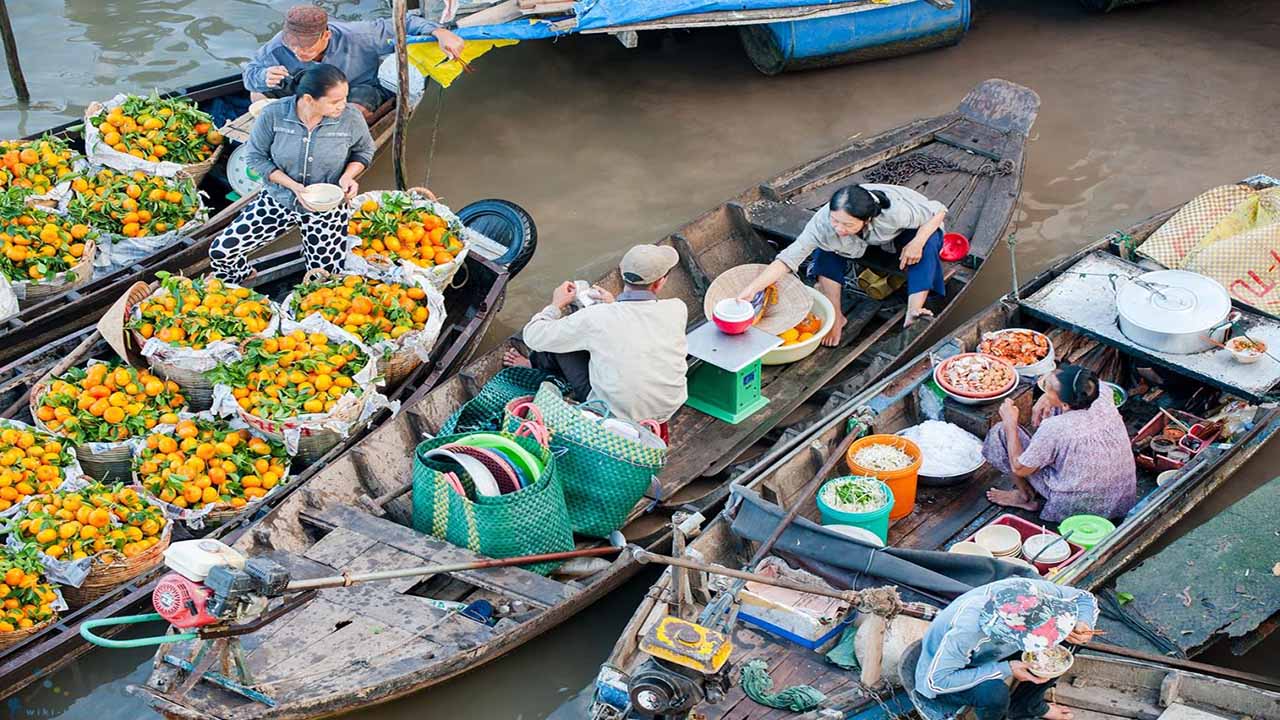
Nga Bay Floating Market: Reveals the unique culture of river trading
04 Sep, 2025
A Market Born from the Rivers In 1915, after a decade of canal construction, the famous seven-river confluence was officially completed. Almost immediately, a spontaneous floating market appeared, drawing hundreds of boats each day. Alongside the waterways, houses and streets grew, creating a remarkable scene of “life above the wharf and below the boat.” During the French colonial period, Nga Bay rose to become the largest waterway hub in southern Vietnam. Its influence on the regional agricultural trade was so great that the French even considered building a major trading port here. For nearly a century, no floating market in the Mekong Delta could rival its scale or fame. At its peak, Nga Bay hosted more than 1,000 boats daily, and during festivals like Tet, the number soared to over 3,000. Nights were illuminated by countless oil lamps swaying on the water, transforming the river into a shimmering lantern festival. A Market That Withstood Change In 2002, the floating market was temporarily relocated to ease waterway congestion and reduce pollution. This move caused its once-vibrant atmosphere to fade. Recognizing its cultural and tourism value, Hau Giang Province restored the market to its original location in 2006, reviving one of the delta’s most cherished traditions. Today, Nga Bay remains a captivating stop for visitors. Seen from above, the confluence resembles a Roman city on water, with river branches stretching like roads to distant villages and towns. Located just 55 kilometers from Can Tho and 180 kilometers from Ho Chi Minh City, the market is both accessible and rewarding to explore. What to Expect at Nga Bay Floating Market Dawn Trading Like most floating markets, Nga Bay comes alive at dawn. Between 5 and 8 a.m., hundreds of boats gather to trade fresh produce. The scene is a feast for the senses: vibrant rambutans, fragrant durians, green coconuts, and countless other seasonal fruits fill the river with color and aroma. Beyond Fruits and Vegetables Nga Bay is famous not only for produce but also for its variety of goods. Livestock such as chickens, fish, turtles—and even snakes—are sold from boats. Shoppers can also find handicrafts and household items, making the market resemble a floating version of a traditional village fair. Meals on the Water Food boats weave through the crowd, offering travelers the chance to savor local delicacies right on the river. A bowl of hot noodle soup or a cup of Vietnamese coffee served on board is an experience not to be missed. Creative Advertising One of the market’s most charming customs is the use of “bẹo”—long poles fixed at the bow of each boat to display the goods being sold. This visual system eliminates the need for shouting across the noisy river, making shopping both practical and fascinating to watch. A Glimpse into River Life Beyond trade, Nga Bay offers insights into the lives of families who spend their entire lives on the water. Their boats serve as floating homes, complete with kitchens, ornamental plants, pets, and even motorbikes. These moving households embody the adaptability and resilience of delta culture. A trip to Nga Bay can be combined with visits to nearby craft villages, traditional boat-making workshops, weaving communities, fruit orchards, and ecological reserves along the seven river branches. Each destination adds another layer to the story of how deeply intertwined life here is with the rivers. For more than a hundred years, Nga Bay Floating Market has symbolized the cultural heartbeat of the Mekong Delta. Though it has faced challenges, its revival is a testament to the enduring importance of river trade and community life. To stand at the meeting point of seven rivers, surrounded by a mosaic of boats, is to witness a living tradition that continues to define the spirit of southern Vietnam.
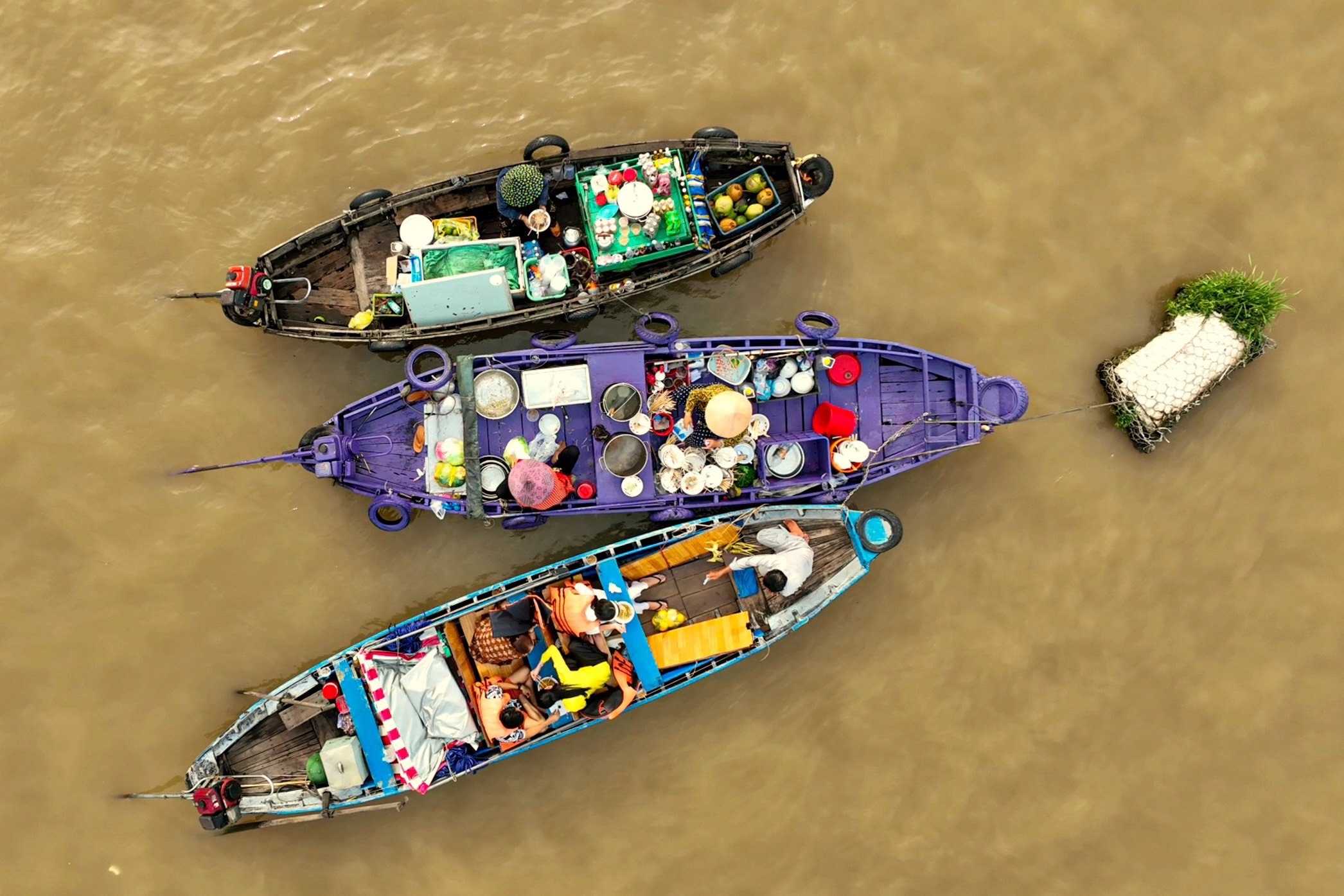
Discover the vibrant life of Cai Rang Floating Market in the Mekong Delta
04 Sep, 2025
Unique Market of the Mekong As one of the most famous floating markets in the Mekong Delta, Cai Rang Floating Market Can Tho is an attractive cultural site. Downstream of Can Tho River in Ninh Kieu District, the market is open around 5:00 AM - 9:00 AM, but the busiest time is from 5:30 AM to 6:30 AM. Having thrived for over a century, Cai Rang Floating Market in Vietnam was established from the long-standing culture of the local people. Floating down the mighty river, the boats act as "mobile apartments” with full interiors such as TVs, stereos, pots, stoves, and even motorbikes. At this floating market in Can Tho, you will see how people trade products. In front of your eyes are traders juggling fruits from boat to boat, long poles hanging samples of the goods for sale, and lots of boats loaded with seasonal fruits. Cai Rang Floating Market in Can Tho is the largest and most bustling floating market in the Mekong Delta. What makes it unique is the “cay beo” – long bamboo poles where sellers hang samples of their goods, turning the river into a colorful showcase of fruits and produce. Beyond trade, it is also a cultural experience, where visitors can enjoy breakfast on boats with noodle soup or coffee while watching the lively flow of river life. Cai Rang captures the authentic spirit of the Mekong, blending commerce, tradition, and everyday hospitality. Things to do and see The bustling trade scene Cai Rang Floating Market Can Tho is renowned for its vibrant and bustling trade scene, which is a captivating reflection of the trading culture in the Mekong Delta. The market operates daily, with the liveliest hours being in the early morning. The trading process at Cai Rang Floating Market is a lively affair. Vendors use loudspeakers to advertise their products and engage in animated conversations with potential buyers. Bargaining is a common practice, and the market is filled with the sounds of negotiation, laughter, and friendly banter. It’s a fascinating experience to witness the energetic exchange of goods and the vibrant interactions between vendors and customers. Local life on boat The local life on boats at Cai Rang Floating Market Mekong Delta offers a fascinating glimpse into the vibrant culture and unique way of living of this region. The boats on the waterways also offer a glimpse into the daily lives of the people who call them home. You’ll see families going about their daily routines, children playing and studying, televisions on the boats, and locals engaging in various activities. The boats are not only places of commerce but also serve as communal spaces where neighbors gather, share stories, and support one another. Regional products The Mekong Delta Cai Rang floating market is renowned for its diverse range of regional products, providing visitors with a captivating glimpse into the unique flavors and craftsmanship of the Mekong Delta. The market is a hub of agricultural abundance, with boats laden with fresh fruits, vegetables, and herbs. You’ll find an enticing variety of tropical fruits like watermelons, dragon fruits, and rambutans, as well as an assortment of leafy greens, cucumbers, and herbs used in Vietnamese cuisine. Beyond the delectable food offerings, Cai Rang Floating Market Can Tho is also a place to discover the region’s craftsmanship. Local artisans showcase their skills through handmade crafts and traditional products such as woven baskets, handmade pottery, embroidered textiles, etc. Trying local food and drinks Cai Rang Floating Market Can Tho is famous for its vibrant and diverse flavors, showcasing the richness of the Mekong Delta’s culinary traditions. Hu Tieu is absolutely a must-try dish. This flavorful rice noodle soup is known for its delicate balance of flavors and textures. The broth is often made from a combination of pork bones and seafood. It is simmered for hours, resulting in a rich and aromatic base. Even chef Gordon Ramsay declared that the broth in the bowl of noodles he had at Cai Rang was the greatest he had ever had. He was so taken with hu tieu that he made it a challenge on his worldwide famous cooking show, Master Chef US. For those seeking a snack or a light meal, don’t miss out on the delicious banh mi. This Vietnamese-style baguette is filled with grilled pork, pate, pickled veggies, and fresh herbs, offering a delicious blend of flavors and textures. As for drinks, make sure to try the famous Vietnamese iced coffee, known as ca phe sua da. This strong and aromatic coffee is brewed using a traditional drip filter. It is served over ice with a generous amount of sweetened condensed milk. So rich, so creamy. A visit to Cai Rang Floating Market is more than just a sightseeing trip – it is an immersion into the soul of the Mekong Delta. From the lively trading scenes to the warmth of life on boats and the unforgettable flavors of local cuisine, every moment here is an authentic cultural experience. For travelers seeking a true taste of Vietnam’s river culture, Cai Rang remains a destination not to be missed.
Experiences & Activities

Nha Trang Half-Day Snorkeling Adventure with BBQ Onboard
1 day
Relax at Vung Tau Beach Visit Christ the King Statue Explore Whale Temple (Den Ca Ong) Discover the historic White Palace (Bach Dinh) Admire the panoramic sea view at Nghinh Phong Cape

A romantic & adventurous Vietnam journey in 10 days 9 nights
10 days 9 nights
Embark on a captivating 10-day odyssey through Vietnam, perfectly curated for couples seeking both profound cultural immersion and exhilarating adventure. This journey weaves together the ancient charm of Hanoi with the mystical karst landscapes of Halong Bay, offering an overnight cruise under a starlit sky. Discover the imperial grandeur of Hue and the timeless allure of Hoi An, where lantern-lit nights and riverside tranquility set the scene for romance. Venture into the vibrant Mekong Delta, exploring its floating markets and lush waterways. Throughout your trip, you'll experience Vietnam's diverse beauty, from serene sunrises to thrilling activities, creating cherished memories that celebrate your love amidst breathtaking backdrops. This is more than a tour; it's a shared adventure into the heart and soul of Vietnam.

5D4N_HANOI – HALONG ON CRUISE EXPLORATION
5 days 4 nights
Spend 2 days cruising around Halong Bay, Lan Ha Bay or Bai Tu Long Bay. Highlights include Sung Sot Cave and Titop Island for Halong, Cat Ba Island and Dark and Bright Cave for Lan Ha, and Thien Cahn Son Cave and Vung Vien Floating Village for Bai Tu Long. Tour includes accommodation at different luxury levels, meals, activities and round-trip transfers from Hanoi. Overnight cruise around Halong, Lan Ha or Bai Tu Long bay Stay in an air-conditioned cabin with private bathroom Boats and accommodations range from three to five stars Activities can include kayaking, bamboo boat, cooking and tai chi

Highlight North Vietnam 7 days adventure
7 days 6 nights
Are you looking for a destination that’s equal parts adventure, culture, and jaw-dropping scenery? Immerse yourself in breathtaking landscapes, rich history, and culinary delights by getting ready for an unforgettable journey through Highlight North Vietnam 7-Day Adventure. From Hanoi’s bustling streets, the misty town of Sapa to Ninh Binh’s ancient land and natural wonder of Halong bay. This 7-day itinerary is crafted for those seeking adventure, culture, and relaxation. Dive into local experiences, scenic landscapes, and heart of Vietnamese culture!
![[S.I.C] Yen Duc village overnight: 2 day 1 night](https://ilooca-tourdb.itourism.vn//files/thumb/408/285/uploads/content/Yen-Duc-Village-Vietnamese-Local-Life_9_2017_03-770x513_1.jpg)
[S.I.C] Yen Duc village overnight: 2 day 1 night
2 days 1 night
This 2 day 1 night trip includes a nice stay in Viet House, unique village retreat accommodation, surrounded by rice fields in Yen Duc village. Cycling to discover peaceful village, talking with local people and visit their family house should amaze you with lots of cultural sense and fun. Besides that, joining local activities (fishing, gardening, visiting the culture house of village, local market…) bring you close to real experience of a farmers, taste delicious homemade Vietnamese food then enjoy peaceful life in countryside of Vietnam.

The perfect 3-day Sapa itinerary for first-timers
3 days 2 nights
Prepare to be captivated by a journey where mist-shrouded peaks meet vibrant cultural tapestries. This 3-day, 2-night escape from Hanoi plunges you into the heart of Sapa's unparalleled beauty. Imagine tracing the contours of iconic terraced rice fields, a masterpiece sculpted by generations, and breathing in the crisp mountain air. Beyond the breathtaking panoramas, you'll connect intimately with the resilient ethnic minorities – the H'Mong people – in their traditional villages, witnessing ancient customs and intricate handicrafts firsthand. For the ultimate perspective, an optional ascent to Fansipan, "The Roof of Indochina," offers a spectacular vista where clouds dance below your feet. This isn't just a tour; it's an immersive odyssey into the soul of Vietnam's highlands, promising memories that will linger long after you return.
Keep exploring
Top things to do in Floating Markets
FAQs
